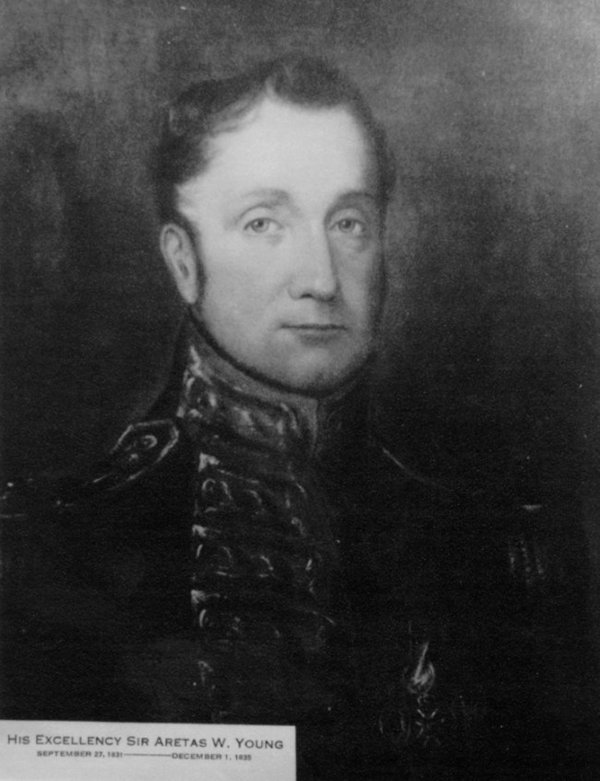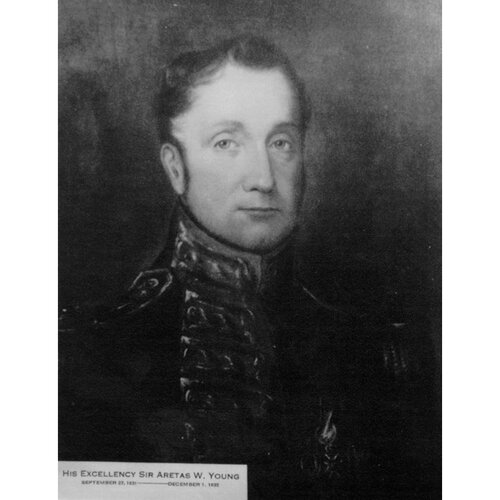
Source: Link
YOUNG, Sir ARETAS WILLIAM, colonial administrator; probably b. 1777; m. Sarah Cox of County Wexford (Republic of Ireland), and they had at least 12 children; d. 1 Dec. 1835 in Charlottetown.
Although Aretas William Young’s origins are obscure, he must have come from a respectable background, since after entering the army as an ensign on 3 Sept. 1795 he was able to purchase a lieutenant’s commission on 28 Oct. 1795 and a captaincy on 15 Sept. 1796. He served in Ireland during the rebellion of 1798 and in Egypt in 1801, and he was aide-de-camp to General Henry Edward Fox in Gibraltar and Sicily between 1804 and 1806. On 17 Dec. 1807 he became a major and until 1812 was engaged in the campaigns in Spain and Portugal against the French, winning a medal at the battle of Talavera. On 25 Jan. 1813 he was made lieutenant-colonel of the 3rd West India Regiment stationed in Trinidad and from 1815 until 1820, when the regiment was disbanded and he was placed on half pay, he commanded the garrison on Tobago. He sufficiently impressed the governor of Trinidad, Sir Ralph James Woodford, that he was placed in charge of the government during Woodford’s leaves of absence from April to July 1820 and from May 1821 to February 1823. Upon his return to office in 1820 Woodford praised Young’s “judicious conduct” and selected him for a seat on the council. In 1820 and again in 1823, the local equivalent of an assembly publicly expressed its satisfaction. In 1826 Young was appointed to the newly created post of protector of the slaves for Demerara (now part of Guyana). He sold his commission in the army and assumed office on 5 June 1826.
Young’s responsibility was to enforce the policy of ameliorating the condition of slaves which the British government had recently adopted to ward off criticism from the anti-slavery lobby in parliament. This policy was viewed unenthusiastically by the owners and nowhere more so than in Demerara, which had one of the largest concentrations of slaves in the British West Indies and had been the scene of a serious insurrection in 1823. Since the protector was supposed to win the confidence of the slaves while securing the cooperation of the local assembly and courts, which were controlled by the white colonists, his position was bound to be an uncomfortable one. Yet Young quickly impressed the governor, Sir Benjamin D’Urban, by his diligence and above all by his “discretion.” In particularly acute cases of abuse, Young was prepared to enforce the law stringently, even if doing so meant incurring the enmity of the white population, but for the most part he was content to act as a mediator between the slaves and their masters rather than as a defender of the slaves. Since it was extremely difficult for slaves to establish proof of maltreatment, Young’s approach effectively meant that conditions on the plantations improved only modestly, if at all. His limited effectiveness was masked to a considerable degree by the inadequacy of his reports to London, for which he was rebuked in 1827 and again in 1829. Moreover, by 1829 the imperial government was shifting away from a policy of exhorting the West Indian colonists to ameliorate the lot of the slaves and towards a program of compulsion. Implicit in this shift was a new and more aggressive role for the protectors of the slaves. Unfortunateloung was insensitive to the changing mood of his superiors and in November 1830 the Colonial Office decided to suspend him. In February 1831 Young hastily departed for London to defend himself. Although unable to persuade the secretary of state, Lord Goderich, that he ought to be reinstated, Young made a convincing case that his conduct had resulted from a misunderstanding of his instructions and his lack of education in the law rather than from wilful disobedience. He was compensated with the post of lieutenant governor of Prince Edward Island, which fell vacant while he was in London.
Young took control of his government on 3 Oct. 1831 at a critical time in the history of Prince Edward Island. The election of William Cooper* to the assembly in a by-election that July had signalled a renewed effort to dispossess the absentee landlords of their vast and frequently neglected estates in the colony. In April 1832 the assembly passed a resolution asking the lieutenant governor to establish a court of escheat. Young had learned from his experience in Demerara the folly of misinterpreting the wishes of his superiors, and his cautious response to the assembly’s petition was to request instructions from London. When Lord Goderich indicated his opposition to the measure, Young hoped that this would put an end to the agitation. Yet Young recognized that the absentee proprietors had contributed comparatively little to the development of the colony and, when the assembly passed a land assessment bill in April 1833 imposing a substantial tax on land, he tried, unsuccessfully, to persuade the Colonial Office to approve the measure because it would encourage the landlords to develop their estates. Although acutely aware of the influence of the proprietors’ lobby in London, Young was also prepared to resist their efforts to use that influence in ways detrimental to the public interest. When several proprietors protested against an act forcing them to contribute to the building of roads across their estates, Young defended the act. When David Stewart, a prominent absentee landlord, persuaded Goderich that he should be allowed to purchase the fishing reserves adjacent to his lot, Young convinced the secretary of state that this purchase would hinder the long-term development of the fisheries.
Although Young sympathized with the assembly’s efforts to develop the colony, the claim made by historian Francis William Pius Bolger that he showed “a deep concern for the plight of the tenantry” is exaggerated. In Demerara his desire to improve the condition of the slaves had been tempered by his commitment to the status quo and on Prince Edward Island his concern for the tenants was similarly circumscribed, as he again tried to mediate between two groups very unequal in power and influence. Thus, although he dismissed as unfounded the reports circulated by the proprietors in London of widespread civil disobedience to the law on the Island, he was willing to assist the landlords in the collection of rents. While Young was absent on a leave of absence between 18 May and 29 Sept. 1834, a minor incident took place at Naufrage when a body of tenants prevented the sheriff from performing his duties. Upon his return Young acted promptly to reassert the authority of the government. Yet he also insisted that the incident had only occurred because of the sheriff’s “want of energy and tact” and dealt with the offenders leniently.
Commenting on Young’s governorship, Thomas Frederick Elliot, the clerk in charge of the North American department at the Colonial Office, warmly praised him for acting “the part of a judicious moderator; restraining any signs of insubordination on the part of the people, and at the same time resisting all attempts of the Proprietors to create unfounded alarm or establish a belief in fictitious grievances.” For this achievement Young had been knighted on 9 July 1834 while he was on leave in London. Yet his success in maintaining harmony on the Island was inevitably transitory. In the elections of December 1834 the escheat movement, led by Cooper, grew in strength and in April 1835 the assembly reiterated its demand for a court of escheat. Resistance to the payment of rents would become more common during the later 1830s. This increasing tension between the tenants and the landlords was reflected in the relationship between the assembly and the Council from the beginning of Young’s term. In the session of 1832 the Council angered the assembly by rejecting a bill imposing a new tax on land, but during the legislative sessions of 1833 and 1834 Young did manage to maintain an uneasy peace between the two houses, partly through the appointment to the Council of men such as John Brecken*, who were not associated with the absentee proprietors. During the 1835 session, however, the assembly and Council disagreed over a wide range of measures and Young was compelled to prorogue the legislature on 10 April even though no supply bill had been passed. He reconvened it on 29 April and after a short session a supply bill was agreed to by both houses, but little else. By this time Young had fallen seriously ill and he authorized a commission consisting of Edward James Jarvis*, Ambrose Lane*, and Thomas Heath Haviland* to prorogue the legislature on 6 May. Despite a modest recovery later in the year, Young died on 1 Dec. 1835.
Sir Benjamin D’Urban described Young as “an Honest and an Honorable Man” and there is no denying that verdict. He was rigidly correct and conscientious in the performance of his assigned duties, with an “affability of manner” which the Charlottetown Royal Gazette praised as “peculiarly pleasing and unconstrained.” But, badly frightened after his dismissal from Demerara, he made it his primary concern to follow his instructions to the letter. He had neither the intelligence nor the influence at home of his immediate successors, Sir John Harvey* and Sir Charles Augustus FitzRoy*, and so took few positive steps to redress the grievances of which the tenants of Prince Edward Island justly complained. That Young was appointed at all is a clear indication of the limited interest of the Colonial Office in the affairs of Prince Edward Island. That his accomplishments were meagre is therefore not surprising.
The major sources for this study were the Colonial Office records in the PRO for Trinidad (CO 295/50–59), British Guiana (CO 111/54–72 and CO 112/6–7, 112/15), and Prince Edward Island (CO 226/49–52 and CO 227/7–8). The journals of the House of Assembly and Legislative Council of P.E.I. can also be found in CO 229/7–8. Details about Young’s military career have been taken from G.B., WO, Army list, and from the DNB. There is a brief obituary on 22 Dec. 1835 in the Charlottetown Royal Gazette and many references to Young during the years 1832–35. Duncan Campbell’s History of Prince Edward Island (Charlottetown, 1875; repr. Belleville, Ont., 1972), 78–82, contains a brief sketch of Young’s career there, and Canada’s smallest prov. (Bolger), 98–105, a rather more substantial one.
Cite This Article
Phillip Buckner, “YOUNG, Sir ARETAS WILLIAM,” in Dictionary of Canadian Biography, vol. 6, University of Toronto/Université Laval, 2003–, accessed December 17, 2024, https://www.biographi.ca/en/bio/young_aretas_william_6E.html.
The citation above shows the format for footnotes and endnotes according to the Chicago manual of style (16th edition). Information to be used in other citation formats:
| Permalink: | https://www.biographi.ca/en/bio/young_aretas_william_6E.html |
| Author of Article: | Phillip Buckner |
| Title of Article: | YOUNG, Sir ARETAS WILLIAM |
| Publication Name: | Dictionary of Canadian Biography, vol. 6 |
| Publisher: | University of Toronto/Université Laval |
| Year of publication: | 1987 |
| Year of revision: | 1987 |
| Access Date: | December 17, 2024 |



